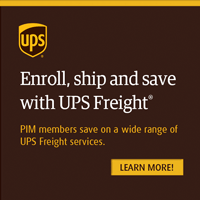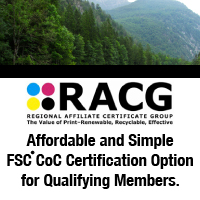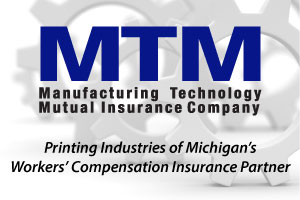
Nov 6, 2017 | Sales & Marketing

By Joe Rickard
Getting in front of senior executives can quickly change the future of a salesperson or a printing company. There is no better way to quickly develop and generate large sales than to gain access to senior decision makers.
Great printing salespeople can impact decisions about strategy, budgets, and marketing that are driven by senior levels of management. Many of these decisions cannot be found in the purchasing or department manager levels.
Executives want to talk to salespeople who can help them address their “big” problems and opportunities. For salespeople, that requires confidence, a thorough knowledge of graphic and digital communications, and an ability to bring creative ideas to their customers.
There are two great outcomes of an executive sales call: one is to gain agreement that what you have to offer is valuable to the executive’s organization; and two, the executive opens the organization to further sales meetings.
FIVE STEPS FOR A GREAT EXECUTIVE MEETING
1. Preparation It may take hours of preparation to gain just one great meeting with the right executive. It is worth it. The first challenge is to identify those CEOs, presidents, division presidents, and executive VPs in each targeted account. Having detailed information about their company, its objectives, its campaigns, and programs will increase the likelihood of success in securing the first meeting.
With gatekeepers blocking the way, and the likelihood that the target will not pick up the phone, a brief and impactful talk track to generate interest must be prepared in advance. In a few cases, the executive may actually pick up the phone. A short crisp message and a simple request for a meeting is the best strategy.
2. A Great Entrance A great first impression is vital. Though rapport building is important, keep the superficial banter to a minimum. Executives are looking for information and expertise. A professional appearance and demeanor will help. Briefly state your purpose, a brief overview of why you are there, and what you expect from the meeting. Make sure you share amount of time you will need for this meeting. Then just ask, “Is this okay with you?” A confident start will establish a solid foundation for the rest of the sales call.
3. Share the Dream Once the stage is set, it is time to share what you have discovered about the customer and their problems. You can do this by using facts and research on issues being faced by similar organizations and sharing them in a tailored way.
For instance, as part of your story to a hospital executive looking to expand their services, you could say, “According to the Direct Marketing Association, 83% of people find direct mail easier to absorb than email. We have found that our hospital clients who integrate direct mail along with their digital communications have increased their ability to sell additional and new services to their patients.”
Be prepared to share your case studies on how specifically you have helped similar organizations. By sharing facts about how your company and printing has helped other companies improve their performance, potential customers will want to hear more.
Then follow up with questions like this:
“How are you currently marketing your new clinical services?”
“What is the strategy of the hospital to attract new patients?”
“How will you address the new trends in the market?”
By asking probing questions, listening and letting the customer talk about the company and their priorities, the executive will become part of the sales call. Creating an optimistic vision for the customer will allow the discussion to continue.
4. Sync Up and Discuss Linkages Now is the time when the salesperson connects what has been discussed by the customer to how your company can help. By tailoring and summarizing the key points of the customer’s problems, you will be able to link what you sell to what the customer needs. A good exchange of ideas and agreements on how the salesperson can help the customer will lead to a close.
5. Close for an Open Door The final step is to gain agreement on what needs to be done next. It is rarely the time to close for an order. It is an opportunity to gain the executive’s endorsement for access to key influencers and stakeholders who are involved in the decision chain. The ideal goal is an open door to developing a well-qualified recommendation to visit other departments and staff. Since it often takes much time to gain a good meeting, preparation and execution is paramount. There may never be another chance to get a second meeting.
There has never been a time in recent history where it has been as important for printing salespeople to raise their level of contact within their customer organization. There is so much change in how printing can impact a customer’s top and bottom line that executives will welcome a meeting with a knowledgeable salesperson.

Nov 6, 2017 | Industry News
 Hatteras, Inc. announced today that they have acquired I AM DETROIT, a branded clothing and apparel merchandiser in the city of Detroit, located at 450 W Fort Street.
Hatteras, Inc. announced today that they have acquired I AM DETROIT, a branded clothing and apparel merchandiser in the city of Detroit, located at 450 W Fort Street.
Founded in 2012 by Bryan Young and Brandon Yopp, I AM DETROIT currently markets and produces logo designed wearables including t-shirts, hoodies, hats, clothing and other key advertising specialties to corporate clients and local businesses.
IAD will continue to operate at the same City of Detroit location, now as a subsidiary company of Hatteras, Inc.. The companies will share print resources going forward as they grow production capacity and expand the combined product line-up available at the Fort Street location.
James Nesbitt, Senior Vice President of Hatteras said of the acquisition, “We are excited to have both of IAD’s founders, Bryan Young and Brandon Yopp, join our team. These guys are smart, successful, and contagiously enthusiastic. We’re look- ing forward to building the brand that they founded both downtown and across the country online. We see a lot of cross- marketing opportunities for our products between our current corporate clients and IAD’s client base”.
Founder and President of Hatteras, Claudia Nesbitt also released the following: “We wanted to take an active role in the exciting revitalization currently happening in the city of Detroit. Having a location on Fort Street in the heart of downtown provides us with the perfect opportunity to become a part of this expanded business community.”
Hatteras Inc. is family owned and is one of Michigan’s leading and most diversified printing, imaging, and information distribution companies. Founded 40 years ago, the company now boasts seven manufacturing and service locations and offers a broad mix of sheet-fed, web, wide-format, data driv- en technology, data management, and digital imaging and mailing of all types. Hatteras, Inc. along with its variable print division, Focus 1, serves major corporate partners in a broad selection of industries, including automotive, healthcare, financial, and the public sector. The company is certified by the Women’s Business Enterprise National Council (WBENC), and maintains a comprehensive set of security controls that are independently audited to HIPAA, SOC2 and SSAE 16 standards and is celebrating 40 years of business this year (1977–2017).
For more information, contact: Becky McFarlane, Executive Vice President, 313.624.3300 * bmcfarlane@4hatteras.com

Sep 6, 2017 | Strategy

With Direct Mail
By Summer Gould
Direct mail is a great way to convert prospects and get customers to make more purchases. First of all, direct mail is a physical and tangible medium you can exploit. Using touch as part of the direct mail moment shifts the brain into a deeper level of engagement. Your prospects and customers understand and remember what they read on paper better than what they read on a screen. Make sure that they remember your message.
So how can you harness this power?
1. Attention: First you need to create a mail piece that draws immediate attention with graphics and copy. Keep in mind that the images you select should convey your message. Our brains focus on and process images very quickly, so they are a very important part of your mail piece design. You want your images to help you stand out in the mail box and from the competition. Scope out what they are doing so that you can be better.
2. Integration: Your prospects and customers expect to be able to do more with direct mail. Integrating mobile technology, personalized URLs, as well as physical elements such as special folds or textures to provide a longer engagement process with your mail piece. The longer the interaction the more likely they are to purchase.
3. Simple: Keep your copy easy to understand. Make their decision to buy from you easy. Using less words and more commonly used ones will help you to generate a bigger response. Make sure to avoid the use of acronyms. They can cause confusion and a confused person does not make a purchase.
4. Consistency: Marketers that continue to send direct mail to prospects and customers over a period of time find that they get better response rates. Sending mail to someone on a regular schedule helps to keep your business top of mind. When the right offer arrives at the right time people jump all over it. This is not to say that you should send the same thing over and over again. Change up your offers and images, but make sure your branding stays the same so that they recognize you from the past mailings.
5. Personalization: Use your data to its maximum potential! Make your offers personalized to what your prospects and customers want and need. You can base this on many factors such as purchase history, demographics, psychographics and so on. Just putting someone’s name on a mailer is not the same as a truly personalized piece. Images, offers and messaging should all be part of your personalization. You can group similar people together so that you have less versioning. Look, your competition is looking for ways to beat you, so don’t let them! Stay ahead of them with your marketing planning and execution. The early bird gets the worm in direct mail too, as long as the mail pieces are well thought out with great design, great offers and the right list of people. Be a leader in your marketing by standing out! Get creative with your design and your data to make mail pieces that your competition has never even thought of. The power of a tangible mail piece for your marketing is driving results. Use the printed piece to stand out in ways that digital marketing can’t. Think of texture, cut outs and special folds as a way to really embed your message into the brains of your prospects and customers. Are you ready to get started?

Feb 15, 2017 | Technology

by Charles Groce, CEO of Pearl Street Consulting
Google announced a few weeks ago that the Chrome web browser would start marking sites that don’t support HTTPS as “insecure”, leveraging its web browser market share to improve web security standards. Soon after, Mozilla jumped on board and indicated it would do the same with the Firefox browser.
What does this mean for print and for you? Go to your computer, open your favorite web browser, and try entering in HTTPS:// in front of your company website URL instead of the standard HTTP:// If you get a message about an Insecure Connection, then your site is not secured by what’s called an SSL (Secure Sockets Layer) certificate. The same goes if it’s blocked and won’t load at all.
Without going too much into the technicalities, think of an SSL certificate as a letter from a close business associate endorsing you and your business as authentic. This is what an SSL certificate issuer does for your website. They verify it is where you say it is, that you own it, and then when a potential customer visits your site, tells them that your website is authentic and your web server isn’t trying to steal information. All of this goes on under the hood of your web browser without you having to do anything as a business owner…except have the certificate. Pretty neat huh?
So why didn’t this come up before? Back in the early web, most data online was public text and images. HTTP actually stands for Hyper Text Transfer Protocol, and for the early web this was fine. However as eCommerce began to evolve, and people began to understand how the internet could be used in business transactions, attempts to steal information and defraud users became more sophisticated.
The most classic of these is the so called “man in the middle attack”. Without a way to verify a website resides at a particular server, there’s nothing to stop a third party from pretending to host your website and get information submitted to it by users. Moreover, information intercepted in by an attacker can be sent on to your site in such a way that you think it originated from the legitimate user. Thus neither you nor your customer would know there was a “man in the middle”, passing information back and forth completely undetected.
The solution to this is the SSL certificate, which allows encrypted traffic in the form of the encrypted version of HTTP, HTTPS (HTTPS Secure or HTTP over SSL), and introduces a third party certifier into your internet transactions. Prior to this week, HTTPS was considered optional and really only a necessity for those sites accepting credit card payments over the internet or offering browser-based email access (also known as webmail). As of the end of January, however, SSL has more or less become a practical requirement.
If your site doesn’t have an SSL certificate installed, your customers will start seeing “INSECURE SITE” notifications in their Chrome and Firefox browsers, and may think twice about sending work your way, especially if the data being sent is sensitive and has any liability attached to it. Be smart: reach out to your IT vendor and get this going today.
As far as the costs, that’s mostly for you and your IT vendor to work out. SSL certificates typically cost $50 to $100 dollars and have to be renewed annually. GoDaddy can set you up. However there’s also a free service called Let’s Encrypt which issues SSL certificates, but you may need to have the proper environment for this to be practical.
It’s best to stay ahead of these changes. Google already announced last year that it would begin degrading websites that don’t support HTTPS in their search results. With this latest announcement, they’re changing the web, and making it more secure. When you think about it, this is a historic moment in the life of the internet.
About the author: Charles Groce is the CEO of Pearl Street Consulting, a Michigan-based IT, web, and software consultancy. Charles is also the founder of osforprint.com, an open source technology solutions provider for the printing industry.

Feb 15, 2017 | Sales & Marketing

by John Raithel, President of Colorbar, Inc.
With the challenges of a slower growing economy, salespeople are under increased pressure to sell more work and at better margins. Increased sales performance pressures can and often do rush salespeople through the sales process and mistakes are made. In haste, they fail to fully plan for the sales call and how best to approach their prospect or customer visit. An area that is often overlooked by salespeople is; how will the purchaser perceive or feel about the sales visit? Feeling Empathy.
But is it even possible for salespeople to feel empathy for their customers when their own burden is so great? Yes, it is, and essential to sales success. But what does empathy mean? Webster’s definition is “the capacity to understand or feel what another person is experiencing from within the other being’s frame of reference, i.e., the capacity to place oneself in another’s position”.
Sales trainers touch on the idea of empathy but somewhat miss the mark. Their message for sales success is to be a good listener, find client issues and offer solutions…consultative selling. I agree these skills are very important, but they are not at the core of long-term sales success. Empathy is.
To achieve lasting success, sales professionals must understand and feel what their client is experiencing. They must adapt quickly to their client’s changing frame of reference, and since no buyer or sales situation is ever the same, salespeople need to focus on the skill of feeling empathy.
Empathy comes naturally to some people, but for others it requires more attention and thought. This doesn’t mean that one person is more genuine or better than the other, as long as the capacity to understand or feel what another person is experiencing from within the other being’s frame of reference is achieved.
While researching and preparing for a sales call, think about how your customer may view your findings. Make a list of questions to ask your client that will give you insight on how they feel and think and listening to their answers will give you a better understanding of their world. Also, keep in mind, people in the same organization don’t feel the same or have the same objectives and motivations, or even view problems the same. Your goal is to better understand how each person you are interacting with feels.
Here is just a small list of thoughts that may help you better understand your customer. There are many more that may fit better for you.
How is their day going? Not just your standard meet & greet question “how ya doing?” but are they focusing on your sales visit or is it elsewhere?
Are they feeling appreciated, burdened and overworked?
What is expected of them? Not just their job description, but from their company, themselves.
How are they evaluated? What are their goals? What do they have to deliver to get recognition, promotion or financial reward? What is their company culture? How do they view vendors? Does their personality and business style match their company’s culture and position? By not having empathy for your buyer, they won’t trust you to share their real problems. By not understanding what challenges your customers have, most likely your solutions will be wrong. You can’t just ask them what their problems are unless you first built a trusting relationship built on empathy. If you do, most likely the problem they have is…”the price is too high”.
So, understanding your buyer’s frame of reference is key to becoming a trusted advisor and achieving long-term success. Pre-sales call preparation is the key, even for existing customers. Changes happen quickly today so never assume. Researching companies and people is a lot easier today with social media websites, but don’t let that be your only source. These sites can provide a great deal of information. Company websites tell a lot about the organization by how it looks, etc. When researching buyers, stroll down on their LinkedIn page to see what organizations they follow or groups they belong. How many 1st connections do they have? Remember you’re trying to get a better sense of who they are as people and the culture they work in. Talk to people who may have experience with them. Has your company done business with them in the past, maybe with a different origination? Anything to help you prepare to see the world through your customer’s eyes.
Don’t try to solve problems unless you know for sure that’s what the buyer wants. People don’t always want you to solve their problems. Their employment may exist because of company’s problems and feel threaten when a vendor offers to fix them. You are there to sell, if fixing a problem helps in that goal, great, consulting is a solution.
Don’t assume your technology or efficiencies are important to buyers. Technologies, efficiencies and equipment may be important to some but not to others, even within the same organization. Remember each person in a purchasing role or a purchasing influencing position sees the vender/buyer relationship differently.
Also, don’t mistake how you feel about purchasing it is how others do as well. Not placing yourself in the shoes of your customer will cost you business. Buyers lean to their comfortable buying style, but can and do change according to their internal situations. What worked with them in the past, may not work now, so keep current with your buyers and their companies.
Being a sales professional is a great and rewarding career, but to have long-term success a commitment to constant improvement and empathy is needed. If the commitment to this is lost, soon, so will be the customers. With experience, training and continuing education, you will achieve great success, but always remember, as a strong building starts with a strong foundation, so too must a sales person start with empathy.
About the author: John Raithel, President of Colorbar, Inc. jraithel@colorbarinc.com
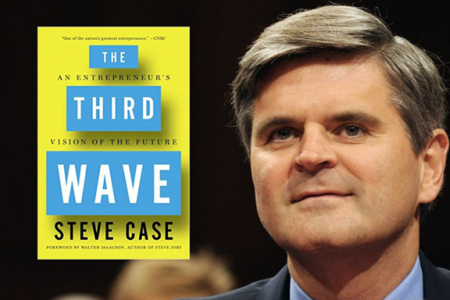
Aug 12, 2016 | History
By Kevin Donley, multimediaman.org

In 1980, Alvin Toffler published The Third Wave, a sequel to his 1970 best-seller Future Shock and an elaboration of his ideas about the information age and its stressful impact on society. In contrast to his first book, Toffler sought in The Third Wave to convince readers not to dread the future but instead to embrace the potential at the heart of the information revolution.

Alvin Toffler
Actually, Alvin—and his co-author wife Heidi Toffler—were among the few writers to appreciate early on the transformative power of electronic communications. Long before the word “Internet” was used by anyone but a few engineers working for the US Department of Defense—and after reporting for Fortune magazine on foundational Third Wave companies like IBM, AT&T and Xerox—Toffler began to hypothesize about “information overload” and the disruptive force of networked data and communications upon manufacturing, business, government and the family.
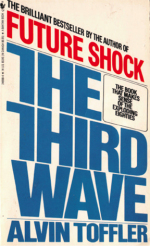
For example, one can read in the The Third Wave, “Humanity faces a quantum leap forward. It faces the deepest social upheaval and creative restructuring of all time. Without clearly recognizing it, we are engaged in building a remarkable new civilization from the ground up. This is the meaning of the Third Wave.” Appearing today as a little excessive, these words would certainly have seemed in 1980 to be a wild exaggeration by two fanatical tech futurists.
But Alvin and Heidi were really onto something. More than 35 years later, who can deny the truth behind Toffler’s basic ideas about the global information revolution and its consequences? The Internet, networked PCs, the World Wide Web, wireless broadband, smartphones, social media and, ultimately, the Internet of Things have changed and are changing every aspect of society.
To his credit, Steve Case—who cofounded the early Internet company America Online—has written a new book called The Third Wave: An Entrepreneur’s Vision of the Future that borrows its title from Toffler’s pioneering work. As Case explains in the preface, he was motivated by Toffler’s theories as a college student because they “completely transformed the way I thought about the world—and what I imagined for the future.”
Steve Case’s The Third Wave
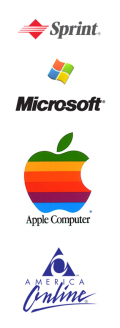
First Wave Internet companies
In Steve Case’s book, “The Third Wave” refers to three phases of Internet development as opposed to Toffler’s stages of civilization. For Case, the first wave was the construction of the “on ramps”—including AOL and others like Sprint, Apple and Microsoft—to the information superhighway. The second wave was about building on top of first wave infrastructure by companies like Google, Amazon, eBay, Facebook, Twitter and others that have developed “software as a service” (SAS).
Case’s Third Wave of the Internet is the promise of connecting everything to everything else, i.e. the rebuilding of entire sectors of the economy with “smart” technologies. While the ideas surrounding what he calls the Internet of Everything are not new—Case does not claim to have originated the concept—the new book does discuss important barriers to the realization of the Third Wave of Internet connectivity and how to overcome them.

Second Wave Internet companies
Case argues that Third Wave companies will require a new set of principles in order to be successful, that following the playbook of Second Wave companies will not do. He writes, “The playbook they need, instead, is one that worked during the First Wave, when the Internet was still young and skepticism was still high; when the barriers to entry were enormous, and when partnerships were a necessity to reaching your customers; when the regulatory system was coming to grips with a new reality and struggling to figure out the appropriate path forward.”
In much of the book, Case reviews his ideas about the transformation of the health care, education and food industries by applying the culture of innovation and ambition for change that is commonly found in Silicon Valley. However, he cautions that current Second Wave models of venture capital investment, views about the role of government and aversion to collaboration among entrepreneurs threaten to stall or kill Third Wave change before it can get started.
The story of AOL
In some ways, the most interesting aspects of Case’s book deal with the origin, growth and decline of America Online (AOL). Case gives a candid explication of the trials and tribulations of his innovative dial-up Internet company from 1983 to 2003. Case explains that prior to the achievement of significant consumer (27.6 million users by 2002) and Wall Street ($222 billion market cap by 1999) success, AOL and its precursors went through a series of near death experiences.
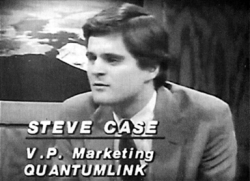
Steve Case in 1987 before the founding of America Online
For example, he tells the story of a deal that he signed with Apple in 1987 that was cancelled by the Cupertino-based company during implementation. Case had sold Apple customer service executives on a partnership with his then Quantum Computer Services to build an online support system called Apple Link Personal Edition that would be offered to customers as a software add-on. Disagreements between Apple and Quantum over how to sell the product to computer users ultimately killed the project.
Facing the termination of the investment funding that was tied to the $5 million agreement, Case and the other founders decided to sue Apple for breach of contract. Acknowledging their liability to Quantum, Apple agreed to pay $3 million to “tear up the contract.” Starting over with their new source of cash, Case and his partners restarted their company as America Online and they made an approach directly to consumers to sign up for their service.
This tale and others reinforces one of the key themes of Case’s book: Third Wave entrepreneurs will need to persevere through “the long slog” to success.
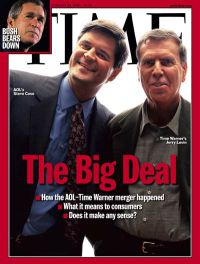
The January 24, 2000 cover of Time magazine with Steve Case and Jerry Levin announcing the AOL-Time Warner merger.
The end of Steve Case’s relationship with AOL is also a lesson in the leadership skills required for Third Wave success. In a chapter entitled “Matter of Trust” (the longest of the book), Steve Case relives the story of the merger/acquisition of Time Warner with/by AOL. It is a cautionary tale of both the excesses of Wall Street valuations during the dot com boom and the crisis of traditional media companies in the face of Third Wave innovation.
Case says that while the combination of AOL with Time Warner in 2000—the largest corporate merger in history up to that point—made sense at the time, two months later the dot com bubble burst and the company lost eighty percent of its value within a year. This was followed by a series of leadership battles that proved there were deep seated feelings of “personal mistrust and lingering resentments” among top Time Warner executives over the business potential of the Internet and the up-start start-up called AOL.
Steve Case writes that, although the dot com crash was certainly a factor, “It came down to emotions and egos and, ultimately, the culture itself. That something with the potential to be the first trillion-dollar company could end up losing $200 billion in value should tell you just how important the people factor is. It doesn’t really matter what the plan is if you can’t get your people aligned around achieving the same objectives.”
What now?
For those of us that were in the traditional media business—i.e. print, television and radio—the word “disruption” hardly describes the impact of the Internet over the past three decades. When companies like AOL were getting started with their modems and dial-up connections, most of us were looking pretty good. We had little time or interest in the tacky little AOL “You’ve Got Mail” audio message. As we reluctantly embraced IBM, Apple and Microsoft as partners in our front office and production operations, we were later making smug remarks about the absurdity of eBay and Amazon as legitimate business ideas.

IoT is at the center of Case’s Third Wave of innovation.
Steve Case’s book represents a timely warning to the enterprises and business leaders of today who similarly dismiss the notions of IoT. He points to Uber and Airbnb and shows that the hospitality and transportation industries are being right now turned on their sides by this new wave of information-enabled “sharing” businesses.
Actually, Case is an unlikely spokesman for the next wave of innovation having personally made out quite well (his net worth stands at $1.37 billion) despite the shipwreck that became AOL Time Warner. If he had been born twenty-five years later, Case could possibly have been another Mark Zuckerberg of Facebook and rode the Second Wave of the Internet (Zuckerberg got his start in coding by hacking AOL Instant Messenger) over the ruins of the dot com bust.
But that was then and this is now. Case has decided to commit himself to investment in present day entrepreneurships through his Revolution Growth venture capital fund. His book is kind of a roadmap for those who want to learn from his experience and bravely launch into the Third Wave of the Internet and build start-ups of a new kind. As Alvin Toffler wrote in Future Shock, “If we do not learn from history, we shall be compelled to relive it. True. But if we do not change the future, we shall be compelled to endure it. And that could be worse.”

Aug 11, 2016 | Strategy

Recently, many of my clients have been asking me this question? I believe there are many reasons why they are asking. Here’s why I think they are concerned:
- The owner or one of the partners is aging and they want to or need to retire.
- The business has seen increases in sales and profits the past year or two which reversed the trends during the recession.
- The fear that one or more of their top clients may leave due to price or go to someone with more capabilities.
- The fear of losing a key employee.
- The equipment is getting old and they need to upgrade. Many are afraid to make a long term financial commitment under the premise they will have more debt when they want to sell.
- The need to change their business model as customer demands change – making wrong choices could jeopardize their business so they would like to merge or sell to someone who they perceive has a rosier future.
- Their workforce is aging. Work has shifted from offset to digital which means in some cases that pressmen are unable to have enough work for 40 hours per week.
- Finding new profitable clients seems harder and harder and the risk of hiring new sales people who may fail is not an attractive option.
- The perception that there is more of a demand and values may be rising as more and more printers are buying competitors as a strategy to grow.
If you can identify with any or all of the above comments, then you may want to find out how much your business is worth. Most agree that the overall business environment is better albeit no one knows how much longer it will last.
Now may be an ideal time to market your business. Buyers are looking for businesses with good clients and trained employees. Some buyers are not looking for another facility and want to tuck your business into theirs. In some instances a buyer may want to move their business into your plant or add volume to your shop and keep the location.
Buyers are also not looking for equipment unless you have new equipment or equipment that the buyer does not have. Sellers that have mailing, wide format, signage or packaging equipment are the most desired. So how much is your business worth? Here’s a guide for a few of the most common scenarios.
- A tuck-in – the largest value in a tuck-in is in the client base.
Buyers are willing to pay for retained sales. They may offer some cash up front and likely to pay royalties or commissions for 2 to 5 years. Royalties can vary from 5% to 15% depending on cash paid up front, the number of payout years and the margin that the buyer will get from the acquired clients. Buyers will buy selected equipment. The seller will have to sell the rest either in an auction or advertise on-line. A good deal is where the seller and buyer share the risk of the retention of clients. Typically the buyer will guarantee some of the deal by paying cash, sign a note with the balance of the purchase price to be paid out based on retained sales.
- A merger – a true merger of two businesses can be an exit strategy for one of the parties or simply a method to consolidate the sales into one location. The overall profits go up with the reduction in expenses of operating two facilities. A larger merged company may be able offer more services to each company’s clients. The value will be based on a combination of the profits and sales that each party contributes to the merged company. A good merger should instantly create a combined company that has more value than each company would have as a standalone. The best merger candidates are companies that complement each other. We have seen many commercial printers merge with digital printers. Printers are also buying mailing companies or sign companies. Good mergers are ones that keep all or most of the equipment from both companies otherwise all redundant or older equipment will have to be sold.

Jul 28, 2016 | Finance Information
By Bodman’s Workplace Law Practice

After years of anticipation, on May 18, 2016, the United States Department of Labor (DOL) issued Final Regulations changing the minimum salary requirements for exempt salaried executive, administrative, professional, and computer employees. This is the first change in DOL Regulations since 2004 when the minimum exempt salary requirement increased from $250 per week to the current $455 per week. The goal of these new Final Regulations is (1) to allow more employees who are currently exempt – and do not receive overtime pay – to be paid overtime (one and one-half times an employee’s regular rate of pay for all hours after 40 hours of work in a workweek) and (2) to raise the pay of many employees that the employer wishes to maintain as exempt. Employers will be forced to make tough payroll decisions regarding who will remain exempt and how to compensate the newly non-exempt employees.
Employees must still meet the existing “duties” test applicable to an executive, administrative, professional, or computer employees. Under the Final Regulations, beginning on December 1, 2016, the minimum amount an employer must pay an exempt salaried employee increases:
- To $913 per week (annually $47,476) for exempt executive, administrative, and professional employees.
- To $134,004 per year for highly compensated employees, which also must include at least $913 per week paid on a salary or fee basis, as defined by the DOL Regulations.
- To $913 per week (annually $47,476) for highly skilled exempt computer employees. These highly skilled computer employees may also be exempt if paid hourly at a minimum of $27.63 per hour (annually $57,470.40), which is unchanged from the current Regulations.
The salary levels will be indexed, with the minimum salary
level evaluated every three years beginning January 1, 2020, effectively guarantying raises for employees at or near the minimum salary level. No changes were made to the outside salesperson category or to the “duties” tests for the executive, administrative, professional and computer exemptions.
One element of the new Rule may benefit employers. Up to 10% of the exempt employee’s salary may be satisfied by the payment of “nondiscretionary bonuses, incentives, and commissions that are paid quarterly or more frequently. If by the last pay period of the quarter, the sum of the employee’s weekly salary plus nondiscretionary bonus, incentive, and commission payments received does not equal 13 times the [required] weekly salary,” the Final Regulations allow for a “catch-up” payment to meet the minimum requirements.
It is incumbent on all employers to remember that a salary under the DOL Regulations is more than just a “salary.” The Regulations define a “salary” as a predetermined amount of compensation paid each pay period with no reduction of pay because of variations of quality or quantity of an employee’s work. A bona fide sick pay policy is required. Deductions from “salary” are limited to those allowed by the DOL Regulations. Employers will be required to take action to meet these new challenges. To be ready for December 1, 2016 and beyond:
- Identify current exempt employees and their salaries;
- Determine the actual weekly hours that current exempt
employees work and their projected future hours over 40 in a
week after December 1, 2016;
- Determine which exempt employees currently earning
less than $913 per week will be kept exempt and receive pay
increases;
- Confirm that the DOL’s non-monetary salary requirements
are met for the exempt employees;
- Ensure that the exempt employees meet the applicable
“duties” test;
- Develop pay plans for the former exempt
Bodman can provide guidance on the new regulations and help your company meet compliance deadlines on
time and in a way it makes most sense for your organization. Contact Workplace Law Practice Group Leader
Maureen Rouse-Ayoub, client alert author Donald H. Scharg, one of the lawyers from the Workplace Law Group,
or your go-to Bodman attorney for more information.
Maureen Rouse-Ayoub
Chair, Workplace Law
Tel: 313-392-1058
Email: mrouse-ayoub@bodmanlaw.com
Donald H. Scharg
Member, Workplace Law
Tel: 248-743-6024
Email: dscharg@bodmanlaw.com
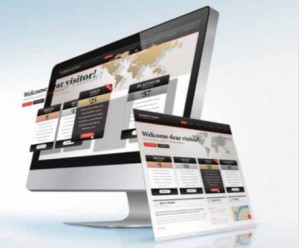
Jun 15, 2016 | Technology
By Charles Groce, CEO of Pearl Street Consulting

You may not have noticed, but March 2014 was a turning point in the history of content consumption and distribution. This was month in which mobile usage overtook desktop usage, the so called “mobile tipping point”. Two yeasr later, mobile continues to climb, with an estimated 1.9 billion global users of mobile devices compared to 1.7 billion desktop users.
This was a tipping point for publishing too, as content distributors needed to stop considering whether they should promote content over mobile and needed to start actually doing it.
Flip books, also known as eBooks or eZines, are a popular piece of software for the printing industry due to its ability to publish online quickly and without distruption to the well established print workflow. If you’re a publisher, you know the drill. Files come in, a PDF is put together, plates are made, and the job is printed. Then comes the part where the eZine is created. All your prepress tech has to do is upload the PDF to an eZine publishing platform and your magazine or other publication is online in 15 minutes.
It is certainly an axiom of publishing to make the consumption of content as convenient as possible for the reader. This is why we see billboards on our way to work, and not out in the middle of nowhere on some billboard farm.
Effectively content delivery over mobile requires a publisher consider the inescapable fact that mobile devices are small, and mobile screens have a limited number of pixels on which to display content. This means, while distributing textual and graphic information, content needs to be displayed more or less in a single column format, easily scrollable using only the reader’s thumb. No zooming or playing around with the interface should be required, since the mobile user may simply leave and find somewhere more convenient to consume this type of content, or they may simply not consume the content at all and move on to something else.
This is why flip books are poison for content being delivered over mobile devices. Flip books are laid out like a book or a magazine, which means in the abstract sense, content is already being distributed using a two column format (left page and right page). But then within each page, there are often multiple columns and complex layouts to convey information. These layouts are beautiful and part of the art of ink on paper. But they are an inconvenience for the mobile content consumer, who has to zoom and and move around the flip book to consume the content.
This is fine if you’re distributing a public annual report over the internet to a board of directors, but for any consumer you’re trying to convince to buy something, or prospective student you’re trying to encourage to sign up for a college program, the inconvenience of the format may run them off.
Before addressing the alternatives, let’s go over some of the statistics that show just how important the mobile internet is today to content distributors.
According to the Pew Research Center, as of October 2014, 91% of Americans have a smart phone. 63% of Americans who own a mobile use their mobile phone to browse the internet, which means 57% of Americans are mobile internet users. This number has doubled since 2009. 34% of mobile internet users use their phone as their primary internet device. This proportion is larger for the younger demographics, meaning that this proportion is guaranteed to continue to grow well into the future.
Publishers who ignore these figures do so at their own peril. We simply cannot ignore the implications for our industry. So now the question becomes: how do we get publication content online in such as a way as to effectively deliver content without adding much overhead to our established print-centric workflow? Flip books are not the answer, for the reasons outlined above. Although flip books do allow publishers to get content online easily and cheaply, their format for mobile web users discourages engagement with whatever call to action is being presented.
If you’re a printer, at best, you can hope your customers who are publishers do not understand this deficiency of the flip book format and are satisfied with the limited but nevertheless online and accessible everywhere flip book. But this doesn’t mean being a good partner. You should be providing solutions to problems, and should demonstrate your understanding of your customers end goals.
Publishers who want to put content online shoudl adopt a “content first/delivery channel neutral” online strategy. This means using a modern content management system, or CMS, which is used to store content in an online database and is designed to distribute content attractively to devices of any size: smart phone, net books, tablets, laptops, and large screen desktops. When a potential customer arrives at your site with their smart phone, the content is delivered in single column format. Later when they show their friends this great new product on their laptop, the content is delivered in multi column format. This is called “responsive design”.
Online marketing content that is delivered responsively see, one study has shown, 35% more engagement to the call to action than online marketing content which is not formatted for all devices. What you’re seeing is these figures are the problems of mobile content delivery I’ve described above. Web sites can suffer from the same formatting issues inherent in flip books. Responsive, device-conscious onlin content delivery methods are a market differentiator, and this means the eventual end of flip books and non-responsive websites alike.
About the author: Charles Groce is the CEO of Pearl Street Consulting, a Michigan-based IT, web, and software consultancy. Charles is also the owner/operator osforprint.com, an open source technology solutions provider for the printing industry.

Apr 2, 2016 | Featured
Presence. Performance. Personalization.
By John Gumina

These three words probably best describe Walsworth Publishing Company, this issue’s Printing Industry of Michigan “Member Profile.”
Along with its facility in St. Joseph, Michigan—acquired just five years ago—the Missouri-based Walsworth has continued to expand its operational presence throughout the U.S., and maintains an international reach as well.
Founded in Missouri in 1937 by Don Walsworth, the company is still family owned and specializes in printing yearbooks, catalogs, periodicals and books. It performs among the 30 largest printing companies in the U.S. overall, and is among the top 10 publications printers and top five book printers. Today, it employs some 1,250 people worldwide.
Walsworth is further distinguished by the fact it is the last privately-held printer of yearbooks among the Big Five, and it has more than 675 employees who have attained “Master Printer of America” status!
According to Tom Ashton, Sales Director, Eastern Region at Walsworth Print Group, at its core the company has a philosophy of placing the client first, and maintains a “big enough to help but small enough to care” approach.
It is this personalization, so to speak, which has kept the majority of clients working with Walsworth for fully 10 years or more.
The St. Joseph, Michigan facility offers a full-service print operation, from receipt of files to shipping out the door. “We have heatset web presses as well as sheetfed presses,” Ashton states. “We can stitch or perfect bind projects across the entire platform, or if sewing and case-binding are needed, rely on our Missouri plant. Following completion, we can ship to a destination, mail through our onsite U.S. Postal verification, co-mail, or hold in our warehouses for ongoing fulfillment and distribution.”The manufacturing operation at St. Joseph occupies 150,000 square feet in its own building. Administrative offices are located across the street in 9,000 square feet, and the Fulfillment Operation occupies 50,000 square feet of warehouse and office space in a 500,000 square foot building nearby.
Walsworth acquired IPC of St. Joseph five years ago from Journal Communications, Ashton points out. This was part of a strategic expansion of Walsworth’s platform, its scope of offerings, the markets it served and its product diversification. (IPC had operated in the St. Joseph region for decades prior to the acquisition, occupying a number of facilities.)
About 195 individuals work at the St. Joseph Walsworth facility today which most recently began implementing a new enterprise wide production system to streamline operations and improve efficiency and tracking.
Ashton states, “We have added several new presses and supporting operations, including platesetters and paper handling equipment. We continue to invest significantly in both our local Michigan operation and across our entire platform. Our annual investment easily exceeds $5,000,000 across our platform, as we seek to improve operations and grow our services. In addition to the pressroom equipment, we have invested significantly in our Integrated Solutions suite of services.” Shortly after Walsworth acquired IPC, Ashton joined the company.
“I am responsible for leading our Eastern Region sales team, selling our entire platform. The team is selling solutions applicable to the catalog, periodical and book markets in addition to ongoing fulfillment services and integrated digital solutions.” Ashton emphasizes “the vast majority” of Walsworth clients have been with the company for 10 years or more.
“We count our clients both in numbers and in longevity,” he adds, noting Walsworth prints many hundreds of focused publications, niche and specialty catalogs, and books of all kinds. But services go beyond this.
Ashton states: “We’ve been working with one long-time client, for example, in revising their website and their marketing strategy to incorporate different conversation streams and methodologies, their approach to new subscriber acquisition, as well as, the layout and design of their magazine.”
This has already resulted in more than an 11% increase in new subscriptions and well over a 200% increase in web traffic, he adds.
In an economy that appears to be growing, but still remains challenging, Ashton states Walsworth: “Continues to identify where we can have the greatest impact on the success of our clients and prospects. We focus our efforts on those activities. By refining our approach we can make our marketing and selling more effective, and negate the need to trim or eliminate.”
What about future plans?
Ashton notes Walsworth is continually investing in both traditional brick-and-mortar operations along with the supporting and complimentary services, such as its “Apps” and “Integrated Solutions” programs.
Walsworth Apps helps its clients to develop and deliver compelling content to readers wherever they are and on whatever devices they use – computer, tablet or smartphone. Ashton adds Walsworth Apps offer a rich content-viewing experience, interactive advertising opportunities and real-time analytic insights along with a new component which reviews, recommends and defines new revenue opportunities for the client.
“Integrated Solutions typically begin with a Digital Presence Assessment, so we can help the client stack rank where to invest time and effort to get the best return. For some, it means revamping the website or tweaking SEO, while for others, it means developing apps with responsive design and frequently updated content. One size doesn’t fit all: we tailor our digital efforts to compliment the traditional printed vehicle so each leverages and enhances the other.”
As a member of its local communities, Walsworth is proud to participate in activities and efforts to support the residents, Ashton points out. “We have been a pacesetter company for the United Way campaign in the past and continue to run an employee campaign each year,” he states. Walsworth’s presence in Michigan also goes beyond the local. “We are proud to partner with Susan G. Komen of Michigan for whom we provide in-kind printing services.”
Walsworth also participates in “green” activities. For example, all of the overhead lighting at its St. Joseph manufacturing operation has been replaced with energy efficient fixtures. “We maintain Forest Stewardship Council (FSC) and Sustainable Forestry Initiative (SFI) certifications for sustainable forest paper products,” Ashton says. “We also recycle 100% of our process waste paper. Additionally, our Sunday web press is a zero-emission press, meaning atmospheric exhaust from that press is water vapor only.”
An active Printing Industries of Michigan member, Walsworth views its membership as “an effective way for us to connect with our colleagues in the industry,” Ashton states. “It helps our organization locate potential production partners, both for specialty applications and overflow resources but also for presenting Walsworth capabilities to other members.”
PIM also serves Walsworth as a method of information consolidation and distribution, both internally and across its local industry, Ashton adds.
For more information about Walsworth, visit its website at walsworth.com, or call Tom Ashton at 269.428.1200. You can also email them either through the website, or through thomas. ashton@walsworth.com




 Hatteras, Inc. announced today that they have acquired I AM DETROIT, a branded clothing and apparel merchandiser in the city of Detroit, located at 450 W Fort Street.
Hatteras, Inc. announced today that they have acquired I AM DETROIT, a branded clothing and apparel merchandiser in the city of Detroit, located at 450 W Fort Street. 






















